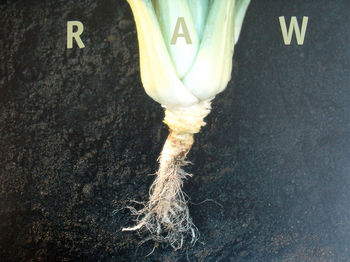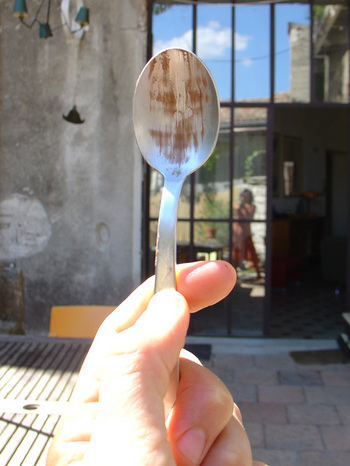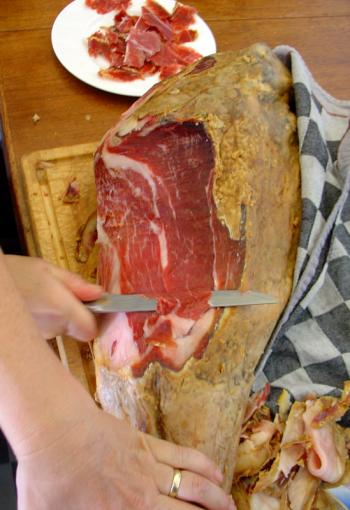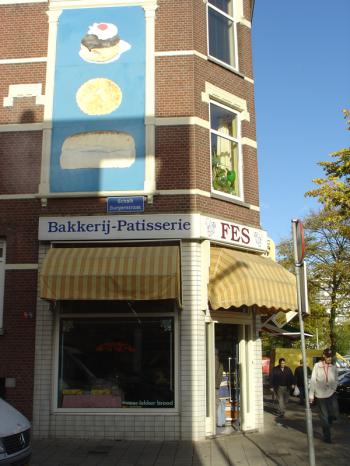Yo, Slip of the Tongue
November 25, 2007
debra at 14:16 | Comments (1) | post to del.icio.us
Food-related film at the IDFA 2007
My IDFA
November 23, 2007
This is my viewing schedule for this year’s IDFA (Int’l Documentary Festival Amsterdam). If you’re here in Amsterdam, let’s meet up and chew the fat about all the good stuff we’ve been watching.
-
Friday, Nov 23
14.15 Tuschinski 2
Dutch Cocaine Factory
Dutch Cocaine Factory sweeps us into the paranoid perception of the world of a 63-year-old cocaine user.
Jeanette Groenendaal 55′, The Netherlands, 2007 WP
View the trailer20.15 Tuschinski 2
Come Back Kate (friend, not food-related)
A fascinating look into the lives of some passionate Kate Bush fans.
Helena Muskens, Quirine Racké 53′, The Netherlands, 2007 WPSaturday, Nov 24 -
19.30 Compagnie KZ (industry/press screening)
Encounters at the End of the World
Herzog’s unmistakable voice-over, English with a German accent, accompanies the images of his visit to the South Pole: “Who were the people I was going to meet at the end of the world?
Werner Herzog 99′, USA, 2007 EPSunday, Nov 25 -
14.00 Tuschinski 1
Hold Me Tight, Let Me Go (not food-related)
A poignant recording of daily life at the Mulberry Bush School, an institution that helps emotionally dysfunctional children reintegrate into society providing them with love and patience.
Kim Longinotto 100′, UK, 2007 IPMonday, Nov 26 -
14:45 Tuschinski 6 (Paradocs 1)
Coffee
Director Ayse Erkmen regularly has a tea leaves reader to predict her future. This does not involve red velour drapes, incense or candlelight. Just a chain-smoking expert who occasionally casts a glance inside a cup.
Ayse Erkmen 25′, Turkey(part of same programme…)
Table Talk is an experimental anthropological documentary that captures a ritual carried out every 1 and 2 November on the Santa Elena peninsula of Ecuador.
Yanara Guayasamin 6′, Ecuador, 2007 WP20:00 Tuschinski 2
Tehran Has No More Pomegranates!
Intelligently edited, hilarious, hurtling, musical compilation of archive footage and newly-shot images offers critical and unadorned portrait of Iranian capital Tehran.
Massoud Bakhshi 68′, Iran, 200622:00 Tuschinski 1
Earth
This film creates a journey through the changing seasons and daily struggle for life across our planet, from rarely seen landscapes to the smallest details in the lives of our best loved, wildest and most elusive creatures.
Alastair Fothergill, Mark Linfield 98′, Germany, UK, 2007Tuesday, Nov 27 -
The Price of Sugar
A profound portrait of Christopher Hartley, a priest who is the only hope for illegal Haitians working as modern-day slaves on sugarcane plantations in the Dominican Republic.
Bill Haney 90′, USA, 2007
View the trailerWednesday, Nov 28 -
10:00 Tuschinski 5 -
Eternal Mash
Tribute to rare, threatened plant species and to Ruurd Walrecht, the man who fought for them for forty years.
Catherine van Campen 53′, The Netherlands, 2007 WP
View the trailer15.15 de Munt 9
Combalimon
An intriguing, sober portrait of a lonely French farmer who cannot decide whether he should sell the family farm.
Raphaël Mathié 80′, France, 2007 IP
View trailer19:00 Compagnie (industry/press screening)
All White in Barking id=34121
All White in Barking shows how several native inhabitants of a London neighbourhood deal with their new neighbours.
Marc Isaacs 73′, UK, 2007 IP22:00 Tuschinski 2
Journey of a Red Fridge
Hari Rai has been hired to carry a red Coca-Cola refrigerator, on his back, through the Himalayan Mountains of Nepal.
Lucian Muntean, Natasa Stankovic 52′, Serbia, 2007 WP
View the trailerThursday, Nov 29 -
The Lie of the Land
Using portraits of English farmers, filmmaker Molly Dineen provides insight into the mechanisms of the food industry and their consequences for agrarian society.
Molly Dineen 74′, UK, 2007 IPFriday, Nov 30 -
10:00 Tuschinski 6
Ours is the Labour
The stories of the first generation of Moroccan labourers that worked at the Dutch rusk factory Hooijmeijer in Barendrecht during the 1960s and 1970s.
Jeroen van Bergeijk 47′, The Netherlands, 2007 WP
View the trailer:14:00 de Munt 11
Darwin’s Nightmare
How the international fish and weapon trade near Lake Victoria consumes the poor population.
Hubert Sauper 107′, France, Belgium, Austria, 2004
View the trailer15:15 Tuschinski 6
Every Day Except Christmas
Shot in black-and-white on 35mm, this 1957 documentary is an impressionistic portrait of the workers at the legendary London Covent Garden Market, which is open 364 days a year.
Lindsay Anderson 40′, UK, 1957Sunday, Dec 02 - (saving the best for last!)
Green Paradise
Portrait of Bert Ydema, an almost retired teacher in a school garden in Amsterdam, who lets pupils experience in practice how extraordinarily beautiful nature is.
Roel van Dalen 48′, The Netherlands, 2007
debra at 14:17 | Comments (0) | post to del.icio.us
Consumer trends 2008
November 12, 2007
Taped to the door of Rotterdam’s most charming North African bakery Fes, there is an update of the global commodities price for cereals and sugar. Bakery Fes situated in the Afrikaanderbuurt, a neighbourhood on the lift and the owners of Fes find it important to offer their clientele an explanation about why their prices are where they are. Aside from this grim message at the threshold of the shop, the crowds at Fes often spill out onto the street.
Oct 29th and 30th, the Culiblog Subculture Club attended a 2-day conference on consumer trends held by Euroforum in Bussum and Hilversum and programmed by Trendbox’s Goos Eilander. The programming focussed on consumer behaviour from the tail end of retail and endeavoured to offer a vision of the future authored by the marketers that analyse consumer behaviours and statistics. Interested in how these future visions would or could influence trends in food and food culture, I prepared for 2 days of crystal bawling. In the back of my mind, I kept thinking of the photocopy taped to the door at Fes.
As consumer desire for transparent food provenance and systems responsibility increases, I thought that I could divine some future visions pertaining to food trends from the more general programme. My critique of this otherwise well-rounded and well-thought professional event is that aside from a few painful questions from the audience most often posed by me, the impact of raw materials, agricultural commodities, food and oil on the realm of consumer trends went largely unmentioned in the presentations that the market researchers put forth. Many speakers spoke only from their client portfolio instead of taking a wider view of relevant projects. In my brief report, I will refer to the speakers whose presentations were most insightful and try to avoid ranting about the others.
Jeroen Boschma, creative director of Keesie, a youth marketing and communications company based in the Netherlands is well known for his book, which translated into English is titled, Generation Einstein; quicker, smarter, and more social. Predictably, he spoke in popular anti-old people tone, which forced me to multi-task so as not to become terribly annoyed. Europe (among other places) is greying but everyone over the age of 24 is an old fart. Boschma described ‘the youth of today’ as being media savvy and as having an acute sense of what is authentic. The kids may be all right but they do not, will not, and are not the slightest bit interested in reading a label. If Boschma/Keesie is correct in this observation, this has implications for all of the carbon neutral and ingredient-labelling schemes that get us text-obsessed old folk off. With regard to product placement and sponsoring, Boschma cited an example of a Snickers-sponsored sports event that his youthful target group continually refused to see as sponsored. Whichever way you want to interpret this, in Boschma’s Snickers example, the kids failed to even perceive the product and were comfortable focussing solely on the event.
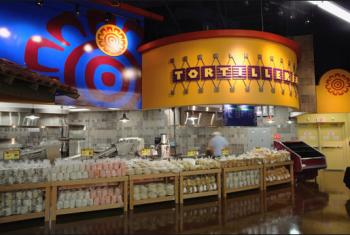
The Carnival Supermarket has a tortilla department
Mandy Saven, deputy editor at GDR Creative Intelligence gets the Culiblog Subculture Club award for showing existing examples of food and cultural diversity in her presentation, alluding to what we can expect in retail environments in the future. Mo’ better cultural pluralism! Saven presented a high-end supermarket catering to Texas-based Latinos called Carnival Supermarket that offers non-traditional supermarket services including health-care and money transfer. Back in the Old Country, the Netherlands may have cultural diversity on a neighbourhood level, when it comes to product assortment, there is precious little cultural plurality in large marketing campaigns and retail expressions. It is almost as if the big players cannot see a market in the Dutch immigrant populations.

Carnival supermarket has an on-site medical clinic
Saven pointed to trends that she thinks will shape the future of retail experience:
• The ability for guests/customers to form live connections/social networks with each other and the presence of a conversation economy associated with products: New York’s Spotlight Live restaurant offers guests the chance to eat, drink and be famous. The dinner guests are the floorshow and there is a live-streaming channel on Spotlight Live’s website. It is like a real life version of MySpace. Culiblog loves the notion of the comfort food menu and some rather large women ‘performing’ Baby Got Back.
• Responsible luxury will become important (and food and cosmetics will be important platforms). E.g., the Kiehls’ flagship store in Stockholm is outfitted with a seminar room and has outlets for ‘user-generated’ content.
• Brand provocateurs will break category norms and divisions (e.g. Carnival Supermarket in Texas).
Behold what I unearthed in a one-minute brand provocateur search geared to the American Southwest:
- Latin Fever expected to drive Hispanic foods and beverages market… Note use of term, Hispanic foods and beverages market!
Food designer Katja Gruijters, presented the only true food-centred trend forecast about products and out of house eating until 2012. Based on a broad mainstream media analysis, Gruijters vision on the future of food pointed to consumer desire for value evolving into value-laden food products and experiences. This sentiment resonated in several presentations the next day in which two of the speakers predicted that spirituality and ethno-religious (food products) becoming increasingly mainstream.
In Gruijters’ vision of the future we can expect:
• A growing market in high quality food products for the elderly as Europe’s population goes silver.
• The rise of the Third Space and consumers demanding a sense of Heim from their food experiences and products wherever they are situated.
• Authenticity, authenticity, authenticity becoming the new location, location, location.
• Global design in local products as communities in Diaspora get wealthier and more homesick
• Short product lifespans on purpose e.g. the Dutch brand Oerbrood creates ephemeral flagship bakeries where the ‘art’ of bread tasting is more important than bread selling. In fact, they were giving the bread away. Open for 6 weeks.
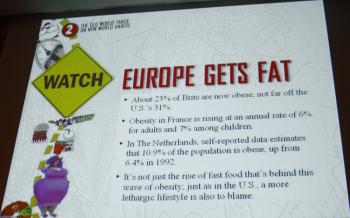
Slide from Marian Salzman’s keynote presentation
Easily the most radically entertaining speaker of the conference was Marian Salzman, one of America’s top futurists. Salzman is credited with spotting the metrosexual, the rising spending power of single urban professional women and she coined the word ‘wigger’ (yipes) on The Oprah Winfrey Show, identifying the cultural trend of suburban white kids kidnapping black street styles. Of Salzman’s predictions, some new, some not so new, these are the most food-related:
• The Old World will take on New World habits – also eating habits. Europe is getting fat.
• Tuning in and out of work: as Europeans begin to work more and the boundary between work and leisure blur, slowing down, proper lunches and dinners with family and no cell-phone will become popular.
• Increasingly prominent role of Islam with 12 million Muslims in Europe, in one generation Muslims will be in the majority in the main European cities in the German, the Netherlands, France and Belgium.
• Eating well and eating organic (especially around the children) becomes a new social currency. In some North American circles children are already only allowed to go to organic and ‘local’ birthday parties.
• Kidults and ‘nest squatters’ delay the onset of adulthood and stay at home longer while the elderly also return to the cosiest nest. If this is a trend, I predict that multi-generation extended families will have a huge impact on food culture.
Salzman’s keynote presentation was general in nature, but I was therefore disappointed that she did not mention more about food – say the impact of importing food from abroad or agricultural policy. Speaking of food in terms of ‘oil’ and ‘raw materials’ played no role in her vision let alone in terms of ‘peak oil’. She kept close to citing trends and phenomena that influence the retail and consumer experience and stayed clear of growing consumer awareness and skepticism about its sustainability of this path – an issue that would interest me as a marketer. In one of the speaker information sheets about Salzman given to us by Euroforum, I spotted and interesting info byte from her new book Next Now describing a loss in faith in government and consumers looking to brands to solve problems. I could not help but start to imagine how big players in food and agriculture might create products and experiences that were an expression of this phenomenon.
Trend forecasting, in its purest and most professional form is nothing short of deeply researched self-fulfilling prophecy. If your job is trend forecasting and of your clients’ business is about providing any sort of large-scale infrastructure, your advice to them (i.e. referring to the realms of colour and texture) will wallpaper the (visual, sensual) environment of millions of people, some of whom are bound to be influencers in their own right. Consumer environments and formats for transaction hugely influence the Zeitgeist, and trends in consumer behaviour, retail environment and transaction formats also deeply influence culture. Some people would consider this a form of culture in its own right.
As I go through my notes from two days of ‘well-researched’ presentations, I cannot get the Fes Bakery’s informal communiqué out of my mind. Undoubtedly the speakers came from their client portfolios and the likes of the Fes Bakery in all of its splendid vernacular style has no need for marketers. Aside from seeing Fes reflected in the ‘rise of Islam’ trend, I cannot stop thinking that the client communiqué taped to their door is one of the clearest trend signals that I’ve seen in a very long time.
The UN’s Food and Agriculture Organisation’s newsroom has something to say about agricultural commoditiesTrendbox, Dutch market research: IN DUTCH UNFORTCH
Keesie, youth marketing and communication: IN DUTCH UNFORTCH
GDR Creative Intelligence, speakers biographies including that of Mandy Saven
Katja Gruijters, food designer
Next Now: Ttrends for the Future by Marian Salzman and Ira Matathia
debra at 15:33 | Comments (1) | post to del.icio.us

